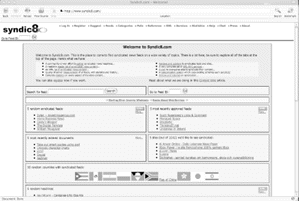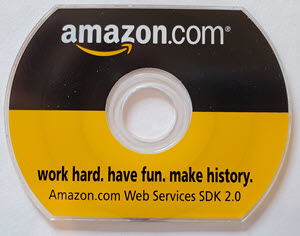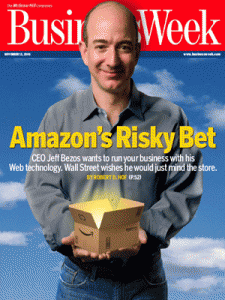AWS News Blog
15 Years of AWS Blogging!
|
|
 I wrote the first post (Welcome) to this blog exactly 15 years ago today. It is safe to say that I never thought that writing those introductory sentences would lead my career in such a new and ever -challenging dimension. This seems like as good of a time as any to document and share the story of how the blog came to be, share some of my favorite posts, and to talk about the actual mechanics of writing and blogging.
I wrote the first post (Welcome) to this blog exactly 15 years ago today. It is safe to say that I never thought that writing those introductory sentences would lead my career in such a new and ever -challenging dimension. This seems like as good of a time as any to document and share the story of how the blog came to be, share some of my favorite posts, and to talk about the actual mechanics of writing and blogging.
Before the Beginning
 Back in 1999 or so, I was part of the Visual Basic team at Microsoft. XML was brand new, and Dave Winer was just starting to talk about RSS. The intersection of VB6, XML, and RSS intrigued me, and I built a little app called Headline Viewer as a side project. I put it up for download, people liked it, and content owners started to send me their RSS feeds for inclusion. The list of feeds took on a life of its own, and people wanted it just as much as they wanted the app. I also started my third personal blog around this time after losing the earlier incarnations in server meltdowns.
Back in 1999 or so, I was part of the Visual Basic team at Microsoft. XML was brand new, and Dave Winer was just starting to talk about RSS. The intersection of VB6, XML, and RSS intrigued me, and I built a little app called Headline Viewer as a side project. I put it up for download, people liked it, and content owners started to send me their RSS feeds for inclusion. The list of feeds took on a life of its own, and people wanted it just as much as they wanted the app. I also started my third personal blog around this time after losing the earlier incarnations in server meltdowns.
 With encouragement from Aaron Swartz and others, I put Headline Viewer aside and started Syndic8 in late 2001 to collect, organize, and share them. I wrote nearly 90,000 lines of PHP in my personal time, all centered around a very complex MySQL database that included over 50 tables. I learned a lot about hosting, scaling, security, and database management. The site also had an XML-RPC web service interface that supported a very wide range of query and update operations. The feed collection grew to nearly 250,000 over the first couple of years.
With encouragement from Aaron Swartz and others, I put Headline Viewer aside and started Syndic8 in late 2001 to collect, organize, and share them. I wrote nearly 90,000 lines of PHP in my personal time, all centered around a very complex MySQL database that included over 50 tables. I learned a lot about hosting, scaling, security, and database management. The site also had an XML-RPC web service interface that supported a very wide range of query and update operations. The feed collection grew to nearly 250,000 over the first couple of years.
I did not know it at the time, but my early experience with XML, RSS, blogging, and web services would turn out to be the skills that set me apart when I applied to work at Amazon. Sometimes, as it turns out, your hobbies and personal interests can end up as career-changing assets & differentiators.
E-Commerce Web Services
In parallel to all of this, I left Microsoft in 2000 and was consulting in the then-new field of web services. At that time, most of the web services in use were nothing more than cute demos: stock quotes, weather forecasts, and currency conversions. Technologists could marvel at a function call that crossed the Internet and back, but investors simply shrugged and moved on.
 In mid-2002 I became aware of Amazon’s very first web service (now known as the Product Advertising API). This was, in my eyes, the first useful web service. It did something non-trivial that could not have been done locally, and provided value to both the provider and the consumer. I downloaded the SDK (copies were later made available on the mini-CD shown at right), sent the developers some feedback, and before I knew it I was at Amazon HQ, along with 4 or 5 other early fans of the service, for a day-long special event. Several teams shared their plans with us, and asked for our unvarnished feedback.
In mid-2002 I became aware of Amazon’s very first web service (now known as the Product Advertising API). This was, in my eyes, the first useful web service. It did something non-trivial that could not have been done locally, and provided value to both the provider and the consumer. I downloaded the SDK (copies were later made available on the mini-CD shown at right), sent the developers some feedback, and before I knew it I was at Amazon HQ, along with 4 or 5 other early fans of the service, for a day-long special event. Several teams shared their plans with us, and asked for our unvarnished feedback.
At some point during the day, one of the presenters said “We launched our first service, developers found it, and were building & sharing apps within 24 hours or so. We are going to look around the company and see if we can put web service interfaces on other parts of our business.”
This was my light-bulb moment — Amazon.com was going to become accessible to developers! I turned to Sarah Bryar (she had extended the invite to the event) and told her that I wanted to be a part of this. She said that they could make that happen, and a few weeks later (summer of 2002), I was a development manager on the Amazon Associates team, reporting to Larry Hughes. In addition to running a team that produced daily reports for each member of the Associates program, Larry gave me the freedom to “help out” with the nascent web services effort. I wrote sample programs, helped out on the forums, and even contributed to the code base. I went through the usual Amazon interview loop, and had to write some string-handling code on the white board.
Web Services Evangelist
A couple of months in to the job, Sarah and Rob Frederick approached me and asked me to speak at a conference because no one else wanted to. I was more than happy to do this, and a few months later Sarah offered me the position of Web Services Evangelist. This was a great match for my skills and I took to it right away, booking events with any developer, company, school, or event that wanted to hear from me!
Later in 2003 I was part of a brainstorming session at Jeff Bezos’ house. Jeff, Andy Jassy, Al Vermeulen, me, and a few others (I should have kept better notes) spent a day coming up with a long list of ideas that evolved into EC2, S3, RDS, and so forth. I am fairly sure that this is the session discussed in How AWS Came to Be, but I am not 100% certain.
Using this list as a starting point, Andy started to write a narrative to define the AWS business. I was fortunate enough to have an office just 2 doors up the hall from him, and spent a lot of time reviewing and commenting on his narrative (read How Jeff Bezos Turned Narrative into Amazon’s Competitive Advantage to learn how we use narratives to define businesses and drive decisions). I also wrote some docs of my own that defined our plans for a developer relations team.
We Need a Blog
As I read through early drafts of Andy’s first narrative, I began to get a sense that we were going to build something complex & substantial.
 My developer relations plan included a blog, and I spent a ton of time discussing the specifics in meetings with Andy and Drew Herdener. I remember that it was very hard for me to define precisely what this blog would look like, and how it would work from a content-generation and approval perspective. As is the Amazon way, every answer that I supplied basically begat even more questions from Andy and Drew! We ultimately settled on a few ground rules regarding tone and review, and I was raring to go.
My developer relations plan included a blog, and I spent a ton of time discussing the specifics in meetings with Andy and Drew Herdener. I remember that it was very hard for me to define precisely what this blog would look like, and how it would work from a content-generation and approval perspective. As is the Amazon way, every answer that I supplied basically begat even more questions from Andy and Drew! We ultimately settled on a few ground rules regarding tone and review, and I was raring to go.
I was lucky enough to be asked to accompany Jeff Bezos to the second Foo Camp as his technical advisor. Among many others, I met Ben and Mena Trott of Six Apart, and they gave me a coupon for 1000 free days of access to TypePad, their blogging tool.
We Have a Blog
Armed with that coupon, I returned to Seattle, created the AWS Blog (later renamed the AWS News Blog), and wrote the first two posts (Welcome and Browse Node API) later that year. Little did I know that those first couple of posts would change the course of my career!
I struggled a bit with “voice” in the early days, and could not decide if I was writing as the company, the group, the service, or simply as me. After some experimentation, I found that a personal, first-person style worked best and that’s what I settled on.
In the early days, we did not have much of a process or a blog team. Interesting topics found their way in to my inbox, and I simply wrote about them as I saw fit. I had an incredible amount of freedom to pick and choose topics, and words, and I did my best to be a strong, accurate communicator while staying afield of controversies that would simply cause more work for my colleagues in Amazon PR.
Launching AWS
 Andy started building teams and I began to get ready for the first launches. We could have started with a dramatic flourish, proclaiming that we were about to change the world with the introduction of a broad lineup of cloud services. But we don’t work that way, and are happy to communicate in a factual, step-by-step fashion. It was definitely somewhat disconcerting to see that Business Week characterized our early efforts as Amazon’s Risky Bet, but we accept that our early efforts can sometimes be underappreciated or even misunderstood.
Andy started building teams and I began to get ready for the first launches. We could have started with a dramatic flourish, proclaiming that we were about to change the world with the introduction of a broad lineup of cloud services. But we don’t work that way, and are happy to communicate in a factual, step-by-step fashion. It was definitely somewhat disconcerting to see that Business Week characterized our early efforts as Amazon’s Risky Bet, but we accept that our early efforts can sometimes be underappreciated or even misunderstood.
Here are some of the posts that I wrote for the earliest AWS services and features:
SQS – I somehow neglected to write about the first beta of Amazon Simple Queue Service (Amazon SQS), and the first mention is in a post called Queue Scratchpad. This post references AWS Zone, a site built by long-time Amazonian Elena Dykhno before she even joined the company! I did manage to write a post for Simple Queue Service Beta 2. At this point I am sure that many people wondered why their bookstore was trying to sell messages queues, but we didn’t see the need to over-explain ourselves or to telegraph our plans.
S3 – I wrote my first Amazon S3 post while running to catch a plane, but I did manage to cover all of the basics: a service overview, definitions of major terms, pricing, and an invitation for developers to create cool applications!
EC2 – EC2 had been “just about to launch” for quite some time, and I knew that the launch would be a big deal. I had already teased the topic of scalable on-demand web services in Sometimes You Need Just a Little…, and I was ever so ready to actually write about EC2. Of course, our long-scheduled family vacation was set to coincide with the launch, and I wrote part of the Amazon EC2 Beta post while sitting poolside in Cabo San Lucas, Mexico! That post was just about perfect, but I probably should have been clear that “AMI” should be pronounced, and not spelled out, as some pundits claim.
EBS – Initially, all of the storage on EC2 instances was ephemeral, and would be lost when the instance was shut down. I think it is safe to say that the launch of EBS (Amazon EBS (Elastic Block Store) – Bring Us Your Data) greatly simplified the use of EC2.
These are just a few of my early posts, but they definitely laid the foundation for what has followed. I still take great delight in reading those posts, thinking back to the early days of the cloud.
AWS Blogging Today
Over the years, the fraction of my time that is allocated to blogging has grown, and now stands at about 80%. This leaves me with time to do a little bit of public speaking, meet with customers, and to do what I can to keep up with this amazing and ever-growing field. I thoroughly enjoy the opportunities that I have to work with the AWS service teams that work so hard to listen to our customers and do their best to respond with services that meet their needs.
We now have a strong team and an equally strong production process for new blog posts. Teams request a post by creating a ticket, attaching their PRFAQ (Press Release + FAQ, another type of Amazon document) and giving the bloggers early internal access to their service. We review the materials, ask hard questions, use the service, and draft our post. We share the drafts internally, read and respond to feedback, and eagerly await the go-ahead to publish.
Planning and Writing a Post
 With 3100 posts under my belt (and more on the way), here is what I focus on when planning and writing a post:
With 3100 posts under my belt (and more on the way), here is what I focus on when planning and writing a post:
Learn & Be Curious – This is an Amazon Leadership Principle. Writing is easy once I understand what I want to say. I study each PRFAQ, ask hard questions, and am never afraid to admit that I don’t grok some seemingly obvious point. Time after time I am seemingly at the absolute limit of what I can understand and absorb, but that never stops me from trying.
Accuracy – I never shade the truth, and I never use weasel words that could be interpreted in more than one way to give myself an out. The Internet is the ultimate fact-checking vehicle, and I don’t want to be wrong. If I am, I am more than happy to admit it, and to fix the issue.
Readability – I have plenty of words in my vocabulary, but I don’t feel the need to use all of them. I would rather use the most appropriate word than the longest and most obscure one. I am also cautious with acronyms and enterprise jargon, and try hard to keep my terabytes and tebibytes (ugh) straight.
Frugality – This is also an Amazon Leadership Principle, and I use it in an interesting way. I know that you are busy, and that you don’t need extra words or flowery language. So I try hard (this post notwithstanding) to keep most of my posts at 700 to 800 words. I’d rather you spend the time using the service and doing something useful.
Some Personal Thoughts
Before I wrap up, I have a couple of reflections on this incredible journey…
Writing – Although I love to write, I was definitely not a natural-born writer. In fact, my high school English teacher gave me the lowest possible passing grade and told me that my future would be better if I could only write better. I stopped trying to grasp formal English, and instead started to observe how genuine writers used words & punctuation. That (and decades of practice) made all the difference.
Career Paths – Blogging and evangelism have turned out to be a great match for my skills and interests, but I did not figure this out until I was on the far side of 40. It is perfectly OK to be 20-something, 30-something, or even 40-something before you finally figure out who you are and what you like to do. Keep that in mind, and stay open and flexible to new avenues and new opportunities throughout your career.
Special Thanks – Over the years I have received tons of good advice and 100% support from many great managers while I slowly grew into a full-time blogger: Andy Jassy, Prashant Sridharan, Steve Rabuchin, and Ariel Kelman. I truly appreciate the freedom that they have given me to develop my authorial voice and my blogging skills over the years! Ana Visneski and Robin Park have done incredible work to build a blogging team that supports me and the other bloggers.
Thanks for Reading
And with that, I would like to thank you, dear reader, for your time, attention, and very kind words over the past 15 years. It has been the privilege of a lifetime to be able to share so much interesting technology with you!
— Jeff;
